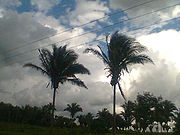
Babassu oil
Encyclopedia

Vegetable fats and oils
Vegetable fats and oils are lipid materials derived from plants. Physically, oils are liquid at room temperature, and fats are solid. Chemically, both fats and oils are composed of triglycerides, as contrasted with waxes which lack glycerin in their structure...
extracted from the seeds of the babassu palm
Attalea speciosa
Attalea speciosa is a palm native to the Amazon Rainforest region in South America...
(Attalea speciosa), which grows in the Amazon
Amazon Basin
The Amazon Basin is the part of South America drained by the Amazon River and its tributaries that drains an area of about , or roughly 40 percent of South America. The basin is located in the countries of Bolivia, Brazil, Colombia, Ecuador, Guyana, Peru, and Venezuela...
region of South America
South America
South America is a continent situated in the Western Hemisphere, mostly in the Southern Hemisphere, with a relatively small portion in the Northern Hemisphere. The continent is also considered a subcontinent of the Americas. It is bordered on the west by the Pacific Ocean and on the north and east...
. It is a non-drying oil
Non-drying oil
A non-drying oil is an oil which does not harden when it is exposed to air. This is as opposed to a to drying oil, which hardens completely, or a semi-drying oil, which partially hardens...
used in food, cleaners and skin products. This oil has properties similar to coconut oil
Coconut oil
Coconut oil is an edible oil extracted from the kernel or meat of matured coconuts harvested from the coconut palm . Throughout the tropical world, it has provided the primary source of fat in the diets of millions of people for generations. It has various applications in food, medicine, and industry...
and is used in much the same context. It is increasingly being used as a substitute for coconut oil. Babassu oil is about 70% lipids, in the following proportions:
|-
| Lauric
Lauric acid
Lauric acid , the saturated fatty acid with a 12-carbon atom chain, is a white, powdery solid with a faint odor of bay oil or soap.-Occurrence:...
>
|-
| Myristic
Myristic acid
Myristic acid, also called tetradecanoic acid, is a common saturated fatty acid with the molecular formula CH312COOH. A myristate is a salt or ester of myristic acid....
|-
| Palmitic
Palmitic acid
Palmitic acid, or hexadecanoic acid in IUPAC nomenclature, is one of the most common saturated fatty acids found in animals and plants. Its molecular formula is CH314CO2H. As its name indicates, it is a major component of the oil from palm trees . Palmitate is a term for the salts and esters of...
|-
| Oleic
Oleic acid
Oleic acid is a monounsaturated omega-9 fatty acid found in various animal and vegetable fats. It has the formula CH37CH=CH7COOH. It is an odorless, colourless oil, although commercial samples may be yellowish. The trans isomer of oleic acid is called elaidic acid...
|-
| Stearic
Stearic acid
Stearic acid is the saturated fatty acid with an 18 carbon chain and has the IUPAC name octadecanoic acid. It is a waxy solid, and its chemical formula is CH316CO2H. Its name comes from the Greek word στέαρ "stéatos", which means tallow. The salts and esters of stearic acid are called stearates...
Lauric
Lauric acid
Lauric acid , the saturated fatty acid with a 12-carbon atom chain, is a white, powdery solid with a faint odor of bay oil or soap.-Occurrence:...
and myristic acid
Myristic acid
Myristic acid, also called tetradecanoic acid, is a common saturated fatty acid with the molecular formula CH312COOH. A myristate is a salt or ester of myristic acid....
s have melting point
Melting point
The melting point of a solid is the temperature at which it changes state from solid to liquid. At the melting point the solid and liquid phase exist in equilibrium. The melting point of a substance depends on pressure and is usually specified at standard atmospheric pressure...
s relatively close to human body temperature, so babassu oil can be applied to the skin as a solid that melts on contact. This heat transfer
Heat transfer
Heat transfer is a discipline of thermal engineering that concerns the exchange of thermal energy from one physical system to another. Heat transfer is classified into various mechanisms, such as heat conduction, convection, thermal radiation, and phase-change transfer...
can produce a cooling sensation. It is an effective emollient.
During February 2008, a mixture of babassu oil and coconut oil was used to partially power one engine of a Boeing 747
Boeing 747
The Boeing 747 is a wide-body commercial airliner and cargo transport, often referred to by its original nickname, Jumbo Jet, or Queen of the Skies. It is among the world's most recognizable aircraft, and was the first wide-body ever produced...
, in a biofuel trial sponsored by Virgin Atlantic Airways
Virgin Atlantic Airways
Virgin Atlantic Airways Limited is a British airline owned by Sir Richard Branson's Virgin Group and Singapore Airlines...
.

